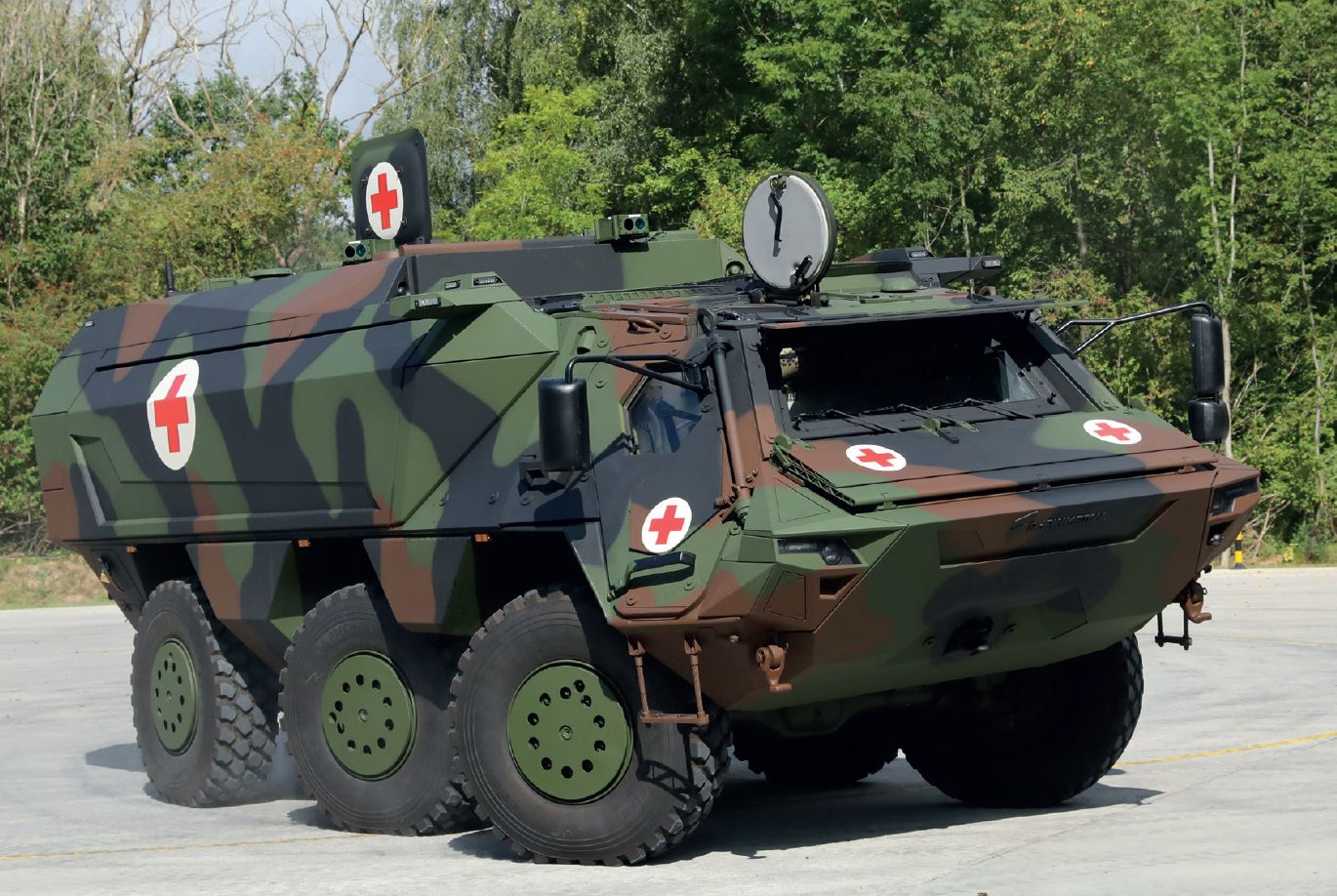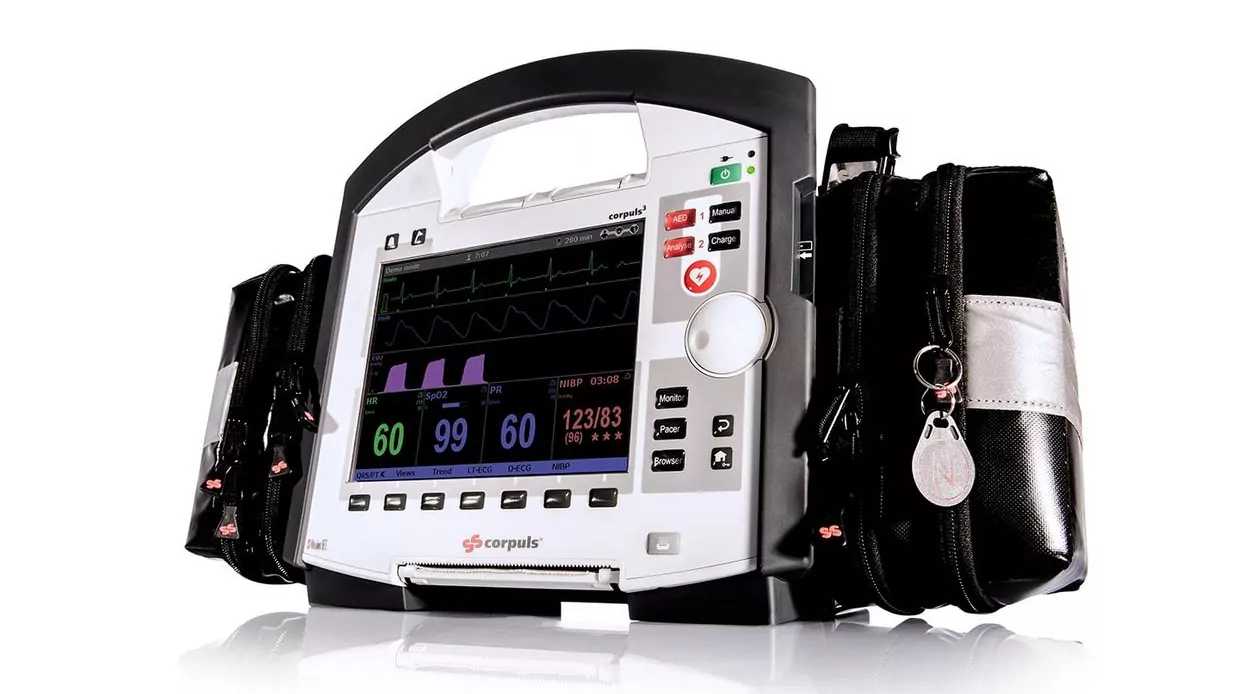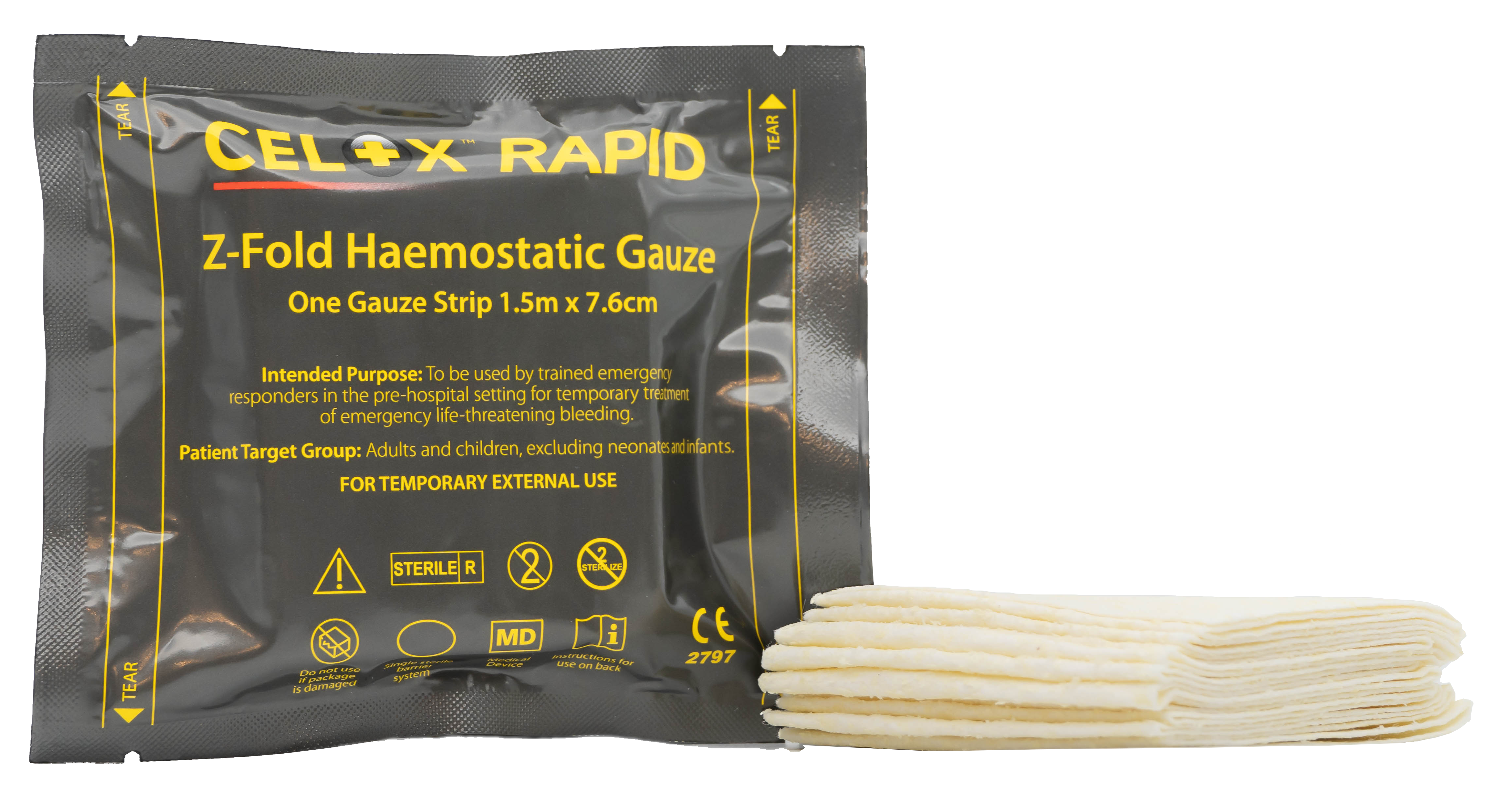The efficient medical evacuation (MEDEVAC) of wounded soldiers from the battlefield follows a planned pathway involving trained personnel using the latest available equipment and medical procedures.
Battlefield wounds often present medical professionals with the most complex injuries encountered. A soldier may be wounded in the remotest of locations, making it all the more urgent for an efficient MEDEVAC to be set in motion as soon after the wound has been sustained as possible – at the point of injury (POI) – to ensure the best possible chance for survival.
This article provides a brief overview of the ground-based MEDEVAC chain used by NATO nations. It includes a look at some of the latest medical devices and interventions that currently equip many of the field ambulances and various medical treatment facilities (MTFs), casualty staging units (CSUs) and other locations along the tactical MEDEVAC path, and includes a look at blood loss and haemostatics.

MEDEVAC in NATO
Within NATO, the Joint Medical Evacuation Concept provides a doctrine for the medical evacuation of casualties within a NATO operational scenario. This encompasses best practices of member states and provides Alliance combatants, as well as other friendly forces operating alongside NATO, with a ‘continuity-of-care’ pathway involving medically-trained personnel, dedicated resources, equipment and latest treatments designed to keep the patient alive throughout the MEDEVAC process, and before strategic repatriation becomes possible. This joint concept is outlined by Colonel Dr. Ingo Hartenstein in his paper, ‘Medical Evacuation Policies in NATO’, which is referred to in this section to provide an overview of the various stages in an allied MEDEVAC chain of events.
The Hartenstein paper emphasises the need for as common and predictable a system as possible to avoid chaos and ensure that casualties suffered in the operational battlespace, can be evacuated along a ‘common and predictable’ system – even under extreme conditions – and, as far as the operational situation allows. MEDEVAC is a pre-planned process, tracked at every stage and with dedicated resources, equipment, ambulances and trained medical personnel. It differs from CASEVAC, which unfolds without such resources and relies on untrained, or basically trained individuals using improvised methods of transport and non-dedicated vehicles to evacuate a patient as rapidly from the battlefield and out of harm’s way as possible, often with no medical equipment other than individual first aid kits (IFAKs).
Hartenstein’s paper explains the three MEDEVAC categories used by NATO, while acknowledging that “individual nations may choose to describe their MEDEVAC activity in different ways, but we must remember that NATO must provide the common framework, that can be appreciated and contributed towards by all NATO national elements”.
The first category described is Forward MEDEVAC, which begins at the POI, “to the initial MTF”, where the first “opportunity for resuscitative intervention” is present. Hartenstein notes that the movement of casualties in Forward MEDEVAC is mainly conducted by ground-based ambulance fleets, although airborne assets can also be employed at this stage. It is in the dedicated wheeled and tracked ambulance fleets and at the MTFs that some of the latest medical equipment and procedures can be brought to bear on life-threatening wounds, thereby improving chances of survival.

(Credit UK MoD Crown Copyright, Cpl Rebecca Brown)
The next category outlined in Hartenstein’s paper is Tactical MEDEVAC, which he describes as the “coordinated transfer of patients within the Joint Operational Area, between available MTFs. The aim of the movement is to advance the casualty to greater care levels to meet the needs of the patient, with the ultimate aim of achieving transfer of the patient to the CSUs and into the final category of MEDEVAC, Strategic MEDEVAC”.
This third and final stage, which will be touched upon only briefly in this article, aims to deliver the patient to advanced and intensive medical care facilities, typically in the casualty’s home country. The transportation means involved depend on available assets for evacuation and may include dedicated ground ambulances, rail cars, as well as airborne assets, depending on distances and numbers of wounded to be transferred.
POI to survival – transport, devices, interventions
Within the defence industry, Rheinmetall produces an armoured field ambulance version of its high-roofed Fuchs armoured transport, unveiled in 2021 (see ESD October 2021). Able to transport four casualties, two lying down and two seated, the ambulance is equipped with intensive care and patient monitoring equipment.

Another ambulance maker is Marshall Land Systems, which has developed several vehicles over the years for NATO members including the UK, Sweden and The Netherlands; one of its most recent is a reconfigurable, Boxer-based, armoured ambulance for The Royal Netherlands Army. With deliveries continuing throughout 2024, the German Bundeswehr’s ambulance corps is receiving 80 highly protected Eagle 6×6 vehicles from General Dynamics European Land Systems (GDELS) over a period of three years following a contract of USD 159 million awarded in 2020 by the German procurement agency, BAAINBw. In a statement at the time, GDELS said the vehicle was selected under the medium protected ambulance vehicle programme (mittleres geschütztes Ambulanzfahrzeug), and closes the gap between the user’s light and heavy ambulance vehicle fleets.
It is on board the ambulances produced by a wide variety of makers, as well as in the MTFs and CSUs along the way, that the latest medical equipment from companies such as Philips, Promoteq, Ortus Technology (Corpuls and Weinmann), Safeguard Medical/Combat Medical, Zoll, (all represented in the Medical Hub at DSEI 2023), play an ever increasing role in aiding the survival of casualties throughout the MEDEVAC process.
Philips, for example, offers an array of solutions; Paul Cropper, the company’s global head military and disaster relief, told ESD during last year’s DSEI, that the company provides effective end-to-end support for casualties along the MEDEVAC pathway. As part of its offer, the company provides lightweight, rugged medic packs with equipment to support triage, diagnose and treat the wounded on the ground and at various stages during evacuation, including its IntelliVue X3 and Tempus Pro units for the monitoring of vital signs, and its HeartStart FR3 (weighing 1.3 kg), professional-grade automated external defibrillator (AED), which has been tested to military standards and certified by the US Army. When it comes to casualties requiring ventilator support, the company’s Trilogy Portable life support ventilators, weighing only 5.6 kg, can provide several hours of life-saving ventilation while transporting patients from POI to MTFs, CSUs and beyond. Philips has also developed a lightweight, portable ultrasound device, displayed at DSEI, for use at any stage of MEDEVAC.

Another industry player with a similar array of end-to-end solutions is Zoll, with automated CPR systems, defibrillators, ventilators and more. Its business development manager of military sales, Maxine Bowley, told ESD at DSEI that the company collaborates closely with its military customers in the development of its medical equipment for military use, thereby ensuring they meet the extreme demands of the MEDEVAC chain of events. Equipment such as its EMV+ portable ventilator, which is suited for use on board ground-based field ambulances of all descriptions, as well as airborne assets, is just one of the devices offered.
Bleeding and clotting
Probably the most common cause of death following an initial wound is blood loss. According to trauma specialists in the military medical field, haemorrhage is responsible for the “vast majority of potentially survivable deaths in combat casualties”, with most fatalities taking place pre-hospitalisation. Leading academics and surgeons in military medicine have agreed in recent years in a wide range of papers on this subject that improving the availability and use of “advanced bleeding control” systems in combat scenarios and throughout the MEDEVAC pathway, will help improve survival rates for those with even the most complex injuries.
One leading specialist in the haemostat field is Celox Medical, whose global product and business development manager, Tim Berrow, spoke with ESD about its solutions and the important role haemostats play from POI along the MEDEVAC chain. The company’s gauze-based Celox Rapid haemostat, for example, takes about one minute to take effect compared with its granule-based haemostats, which can take up to five minutes.

According to Berrow, “Generally, any combatants will be issued with an IFAK containing various components such as haemostats, tourniquets, chest seals, etc, and in the phases of care, such as care under fire where a soldier has suffered a wound resulting in catastrophic bleeding, the Celox haemostat would be used as close to the POI as possible, possibly with the soldier using it on themselves, or a first-line medic using the individual patient’s own IFAK contents to apply the haemostat. They will then enter the tactical field care phase, with the casualty being moved from the battlefield into a dedicated ambulance in the case of MEDEVAC, equipped with more comprehensive medical kits and equipment – the further up the chain you go the more sophisticated the resources and medical bag contents become. That said, the key pieces of equipment within an IFAK will also be present further up the chain.”
Berrow continued, “Celox also supplies chest seals to treat penetrating chest trauma. There are three leading causes of preventable deaths, i.e. when appropriate treatment is delayed; the first is major haemorrhage accounting for about 80%; the next is a compromised airway; and the third is a penetrating chest trauma, or pneumothorax, basically a hole in the chest causing a collapsed lung, or pressure build-up – tension pneumothorax – compressing other vital organs and vessels. This is where the chest seal, like our Foxseal chest seal provides an occlusive dressing with a one-way vent/valve, enabling air to leave the chest, but preventing any from entering. Such a device will be in IFAKs, as well as aboard dedicated field ambulances.”
Historical perspective, new development
Offering background and a historical perspective on battlefield bleeding, Sir Keith Porter, Senior Medical Advisor at Cambcol and a senior trauma surgeon at Birmingham’s Royal Centre for Defence Medicine, told ESD that, “War over millennia has driven advances in care, most significantly during the Afghanistan campaign.” He said the 15th century saw the introduction of ligatures to stop blood loss and in the Napoleonic Wars, the introduction of patient Triage, (French: to sort), and ‘flying ambulances’ – horse-drawn carts to evacuate the most seriously injured soldiers to nearby field hospitals where rapid amputation was the only option for those with severe limb injuries.
By the end of World War I, Porter said blood transfusion was possible, with World War II seeing increased use of blood for transfusion and the introduction of antibiotics, although many troops still died of blood loss in the field. “Both the Korean and Vietnam Wars saw more rapid evacuation of the injured and the introduction of forward surgical capability in clearing stations and field hospitals,” Sir Keith said, “where, despite these advances, haemorrhage was a common cause of death and preventable deaths.” He added that the index injury during the war in Afghanistan was caused by improvised explosive devices resulting in catastrophic limb and pelvic injuries, as well as torso and head trauma. “Without the use of tourniquets and haemostatic dressings, many more lives would have been lost due to blood loss.”
Porter also noted that haemostatic dressings have historically functioned as a ‘bung’ with no intrinsic blood-clotting capability. “What is required is a product that has the ability to up-regulate the natural clotting process and be easy to use and produce consistent results.” At this point, he told ESD about Cambcol’s new Clotta haemostat, which, he said, “provides all of these actions and also has anti-bacterial properties, which reduce potential infection risk, particularly when there are extended casualty evacuation times to definitive care.” He said the new product has the potential for use in all grades of external and internal bleeding.

It is worth noting that with the Russian invasion of Ukraine in February 2022, urgent medical requirements saw the Clotta haemostat released for early export through ProTrainings Europe in April of that year, specifically to aid Ukraine. The company said in a statement at the time that the product would be available soon in the UK, but that stocks were ready for immediate dispatch to Ukraine and other countries that allow “unlicensed haemostatic dressings”.
Providing more detail, Cambcol’s CEO, Jonathan Fitton told ESD that, “Clotta is a collagen-based haemostatic dressing, which uses an innovative formulation to stimulate and enhance natural clotting responses to stop bleeding quickly, unlike the ‘jellified bung’ methods that are very common within this category. It will stop and clot arterial bleeding, right down to minor everyday cuts and scrapes. It is a Class III medical device, due to its invasive use and the fact that it is composed of material of avian animal origin as the source of collagen.”
Fitton continued, “Unlike the standard live-tissue model of a 45-second bleed, Clotta has been used successfully on immediate application following complete severance of the femoral vessels. Data collected so far also shows significant wound healing acceleration; it can also be used in extremes of weather conditions and in both hypo and hyperthermic patients.”
Regarding the product’s use in Ukraine, Fitton added, “it is already being used in Ukraine via charities under a special waiver”.
MEDEVAC from Ukraine
Staying with Ukraine, strategic MEDEVAC is currently being conducted ‘out’ of the country by rail and ambulance into a MEDEVAC hub based in the Polish city of Rzeszów, near the Ukrainian border, and from there by airborne assets to other overseas facilities. According to reports, as of August 2023 more than 2,350 Ukrainian military and civilian patients suffering from serious war wounds, as well as other critical ailments, had been evacuated to hospitals in 21 European countries since the initiation of the EU Civil Protection Mechanism, set in motion in March 2022. With fully trained medical personnel and latest equipment and best-practice treatments, the Polish MEDEVAC hub, acting in the role of a NATO-like CSU, provides patients with sustaining and stabilising care and support before transfer to other overseas facilities, with flights provided by Norway twice a week.
The World Health Organization (WHO) announced in March 2022 that it had donated four additional ambulances for MEDEVAC and repatriation operations from Ukraine to Poland, enabling the Humanosh Foundation to deploy these assets and reinforce MEDEVAC convoys for the Ukrainian Armed Forces, providing evacuation and life-sustaining treatment, transporting critically ill patients from medical facilities across Ukraine to the Medevac Hub in Poland. In a statement, WHO said the ambulances are equipped to transport four patients and include: oxygen tanks, defibrillators, portable ventilators and other equipment. In July 2023, it was announced that the EU and WHO were joining forces to strengthen MEDEVAC operations for Ukraine.
Final word
It is clear that wounded soldiers today stand a far greater chance of survival thanks to the availability of previously unavailable advanced medical equipment and treatment that can be administered close to the POI. Certainly, no soldier wants to end up in need of urgent MEDEVAC, but it must be some consolation to know that the modern MEDEVAC system comprising the latest treatments and medical technology is available, thereby ensuring each and every wounded combatant has the best possible chance of survival under almost any circumstance.
Tim Guest



